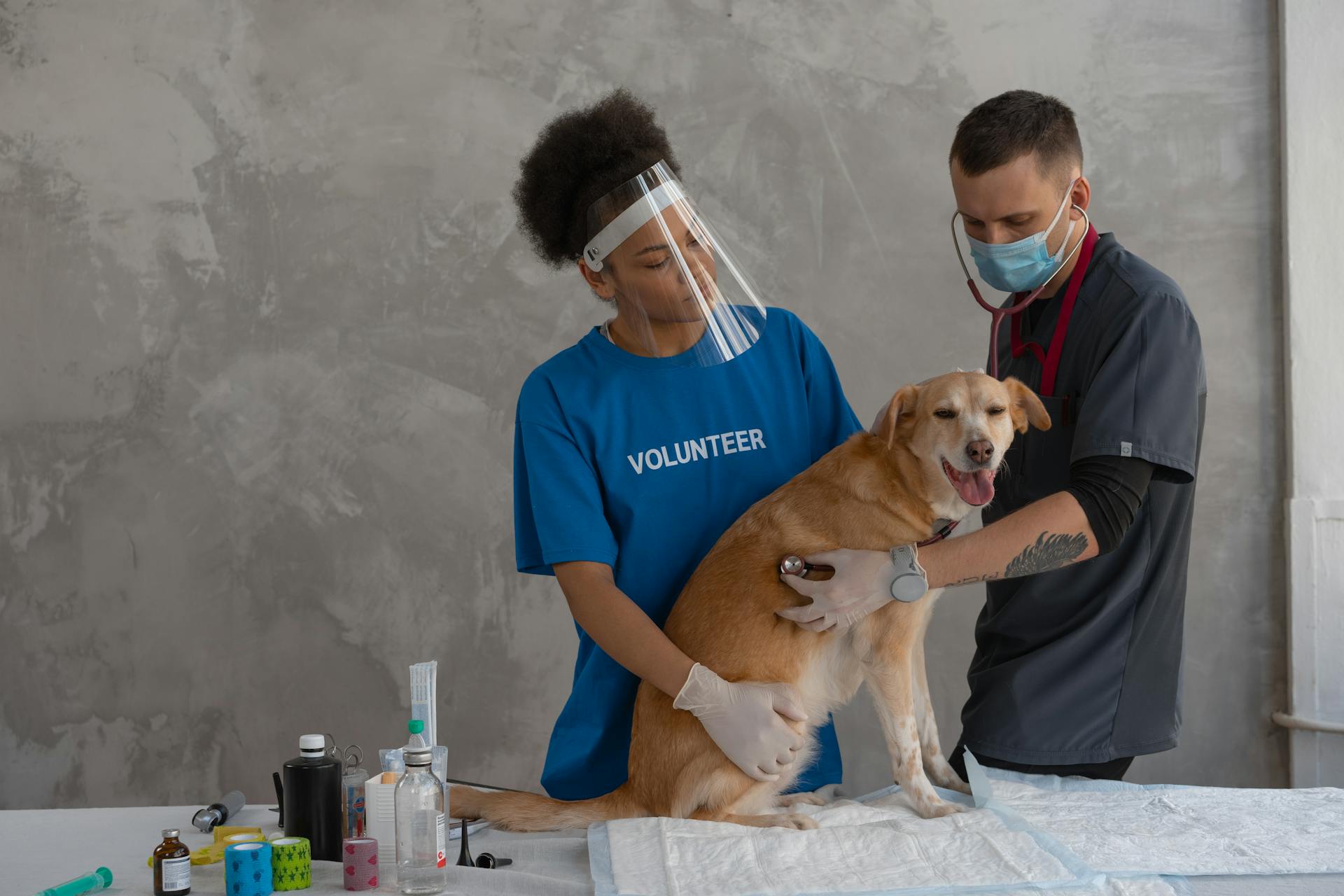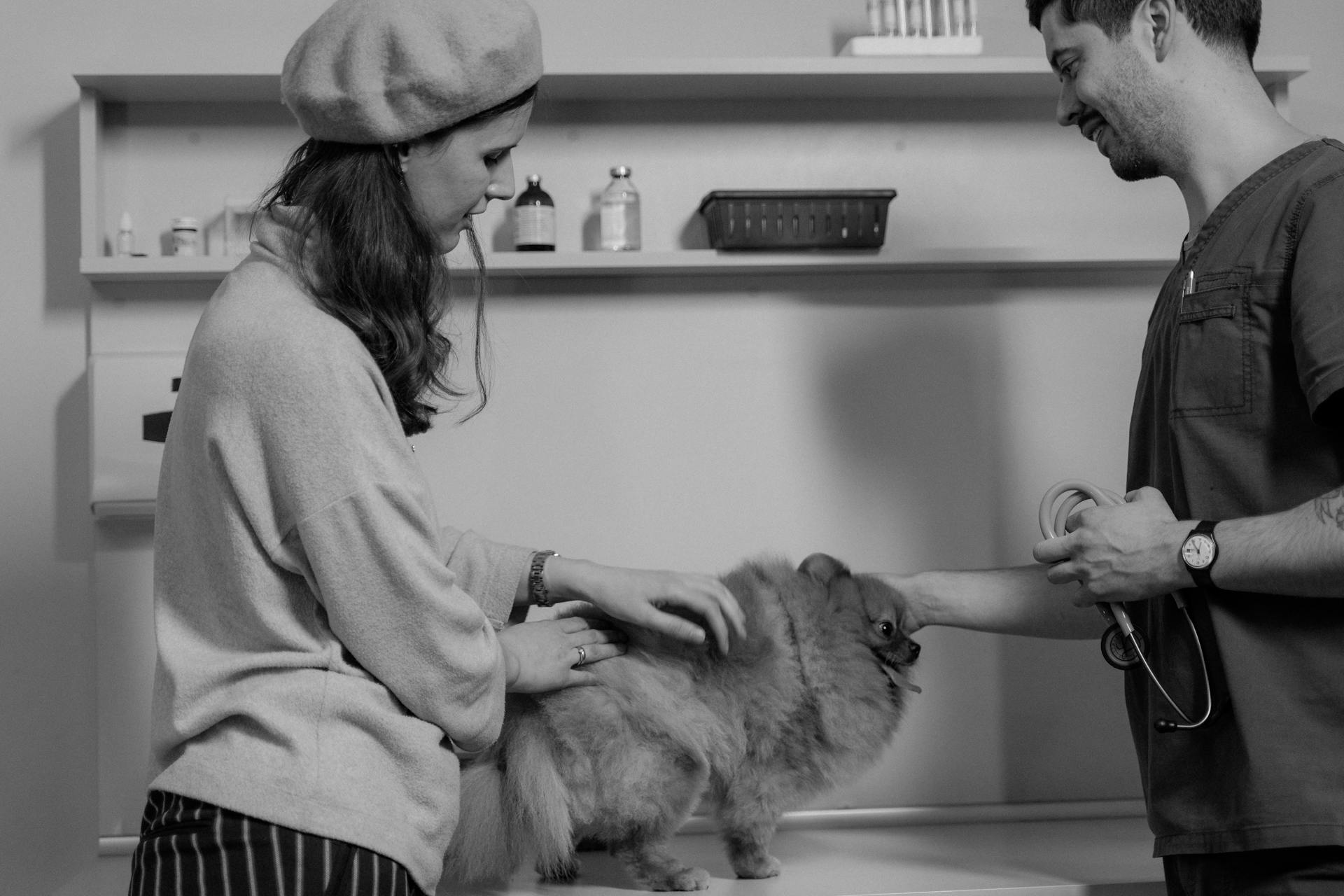
Female dog contraception is a vital aspect of responsible dog ownership, helping to prevent unwanted litters and maintain the overall health and well-being of your furry friend.
Spaying, or ovariohysterectomy, is a common surgical method that involves removing the uterus and ovaries to prevent pregnancy. It's a highly effective method, with a success rate of 99% or higher.
The decision to spay or not should be based on factors such as your dog's age, health, and lifestyle. For example, spaying before the first heat cycle can reduce the risk of certain health issues, like uterine infections.
A well-planned approach to contraception can also help prevent unwanted litters and reduce the risk of certain health problems in your dog.
A unique perspective: How to Avoid Ivdd in Dachshunds
Female Dog Contraception Basics
Female dogs come into heat twice a year on average, and they can conceive only during that time.
Spaying your dog is a recommended method to prevent estrus, or heat, and involves the surgical removal of the entire female reproductive tract.

Ovariohysterectomy, or spay surgery, is a permanent and irreversible procedure that's performed by a veterinarian, and there's little risk associated with it.
Some veterinarians now offer an ovariectomy, where only the ovaries are removed, leaving the uterus, so it's worth asking your veterinarian what they recommend.
Medical management using hormonal drugs is not typically recommended due to risks.
The purpose of spaying is to ensure that the estrus cycle doesn't occur, which reduces the risk of breast cancer and eliminates the risk of ovarian and uterine cancer.
Explore further: Dog Names Female Start with S
Understanding the Estrus Cycle
A female dog's heat cycle, also known as estrus, can last anywhere from two to three weeks on average.
The heat cycle begins with the first signs of vulvar swelling or vaginal discharge, which can be a bit of a mystery to new dog owners.
In most dogs, puberty, or sexual maturity, occurs around six months of age, but this can vary depending on the breed.

Smaller breeds tend to go into heat earlier, some as early as four months, while larger breeds can be up to two years old before they come into heat for the first time.
Female dogs typically come into heat twice a year, but this can vary from dog to dog and even from cycle to cycle.
Some dogs take 18 months to two years to develop a regular cycle, so be patient and keep an eye on your furry friend's unique rhythm.
Expand your knowledge: Good Breeds for Psychiatric Service Dogs
Preventing Unwanted Pregnancies
Spaying your female dog is a recommended and permanent solution to prevent unwanted pregnancies. A spay surgery involves the removal of the entire female reproductive tract, including the uterus and both ovaries.
This procedure is a major abdominal surgery, but it's generally safe when performed by a veterinarian. Some veterinarians now offer an ovariectomy, which removes only the ovaries, leaving the uterus intact.
There's little risk associated with the procedure, making it a great option for dog owners who want to prevent unwanted litters. By spaying your dog, you'll also reduce the risk of breast cancer and eliminate the risk of ovarian and uterine cancer.
If you're not ready for a permanent solution, medical management using hormonal drugs is an option, although it's not typically recommended due to risks.
On a similar theme: How to Prevent Diabetes in Dogs
Spaying and Its Benefits

Spaying your female dog can eliminate the risk of false pregnancy, which can lead to abnormal behaviors and an increased risk of pyometra and mastitis.
Pyometra, a serious and potentially life-threatening condition, is a risk that increases with age in un-spayed females. Spaying eliminates this risk.
Spaying a female dog prior to her first heat cycle reduces her risk of developing breast cancer to less than 0.5%. This number jumps to 8% for a dog that goes through one heat cycle, and 26% for a dog that goes through two heat cycles.
Spaying also provides medical control of estrus, which is currently not available in the United States or Canada through approved medications.
Precautions for Limiting Adverse Effects
If you're considering female dog contraception, it's essential to take precautions to limit adverse effects. Consult a veterinarian to determine the most appropriate treatment and limit the risk of adverse effects, as these medicines have only been available on prescription since 2012.
A fresh viewpoint: Female Dog Neutering Side Effects

Stop treatment immediately and contact a veterinarian if any adverse effects occur, as the risk of serious adverse effects increases with the duration of treatment. Administration should be limited to what is strictly necessary.
The risk of serious adverse effects also increases in the event of overdose, so it's crucial to weigh the animal before each treatment and adjust the dose accordingly. Regular checks should be conducted by the veterinarian in the event of prolonged treatment (more than 3 months).
Here are some important precautions to keep in mind:
- Consult a veterinarian before starting treatment.
- Stop treatment immediately if adverse effects occur.
- Limited treatment to what is strictly necessary.
- Weigh the animal before each treatment and adjust the dose accordingly.
- Regular checks with the veterinarian for prolonged treatment.
Sources
- https://pubmed.ncbi.nlm.nih.gov/11497398/
- https://www.cbc.ca/news/canada/manitoba/canine-birth-control-could-reduce-northern-stray-numbers-1.2558810
- https://healthtopics.vetmed.ucdavis.edu/health-topics/canine/pregnancy-prevention
- https://vcahospitals.com/know-your-pet/birth-control-for-dogs
- https://www.anses.fr/en/content/birth-control-pills-female-cats-and-dogs-must-be-prescribed-veterinarian
Featured Images: pexels.com


